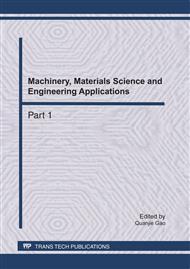p.216
p.222
p.227
p.233
p.237
p.242
p.248
p.253
p.259
Design of Limb of 2R2T 4-DoF Symmetrical Parallel Manipulators
Abstract:
A systematic methodology is presented for design of 2R2T 4-DoF symmetrical parallel manipulators, based on the screw theory. Through analyse the given constraints of the moving platform, using the screw theory and the reciprocal screw theory. According to the reciprocal product between kinetic screw and constraint screw in screw theory, this method firstly creates possible limb structures and then generates different models of mechanism. enumerate the limb twist system. Based on the limb twist system, design the feasible limb structures and the potentially parallel manipulators.
Info:
Periodical:
Pages:
237-241
Citation:
Online since:
April 2011
Authors:
Keywords:
Price:
Сopyright:
© 2011 Trans Tech Publications Ltd. All Rights Reserved
Share:
Citation:


